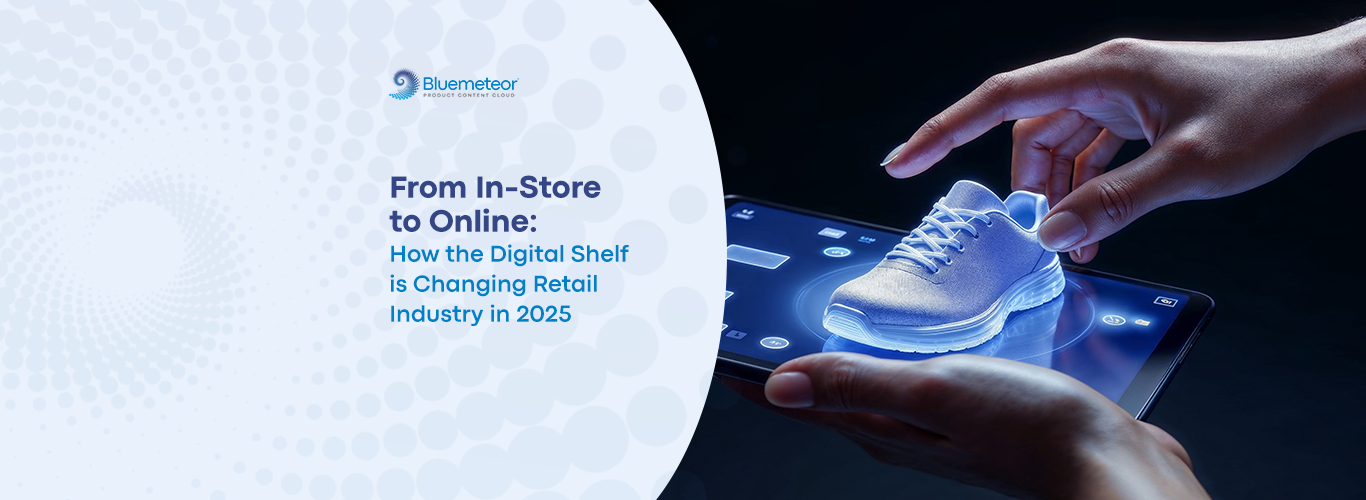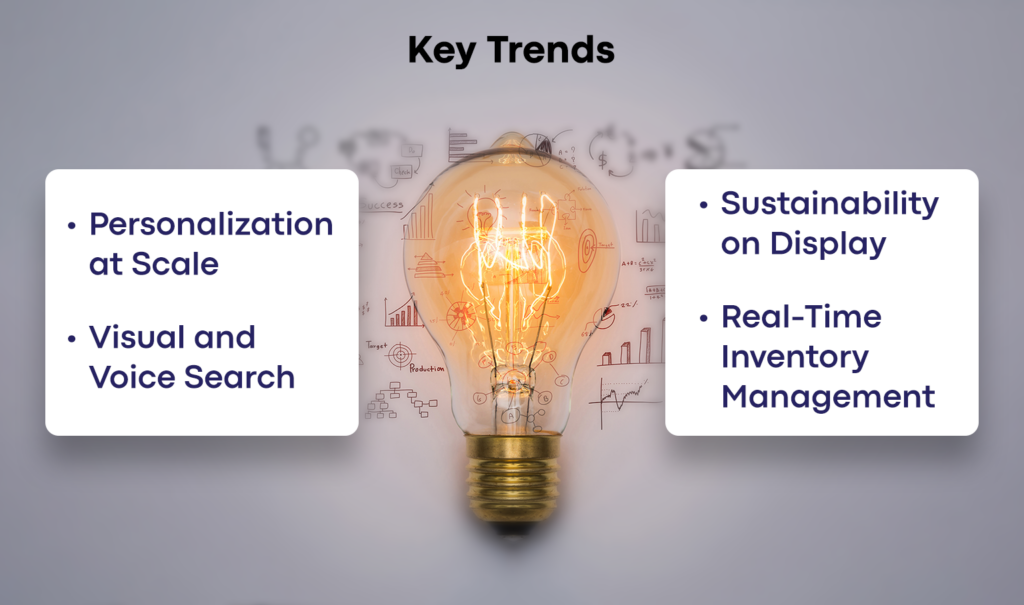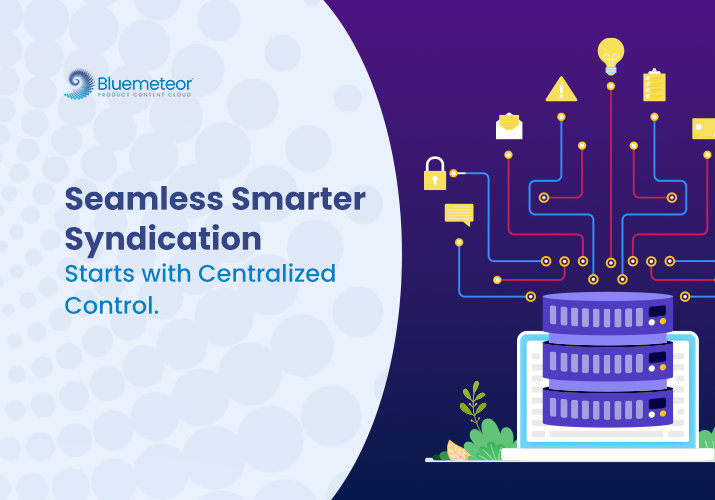From In-Store to Online : How the Digital Shelf is Changing Retail Industry in 2025

What if the future of retail isn’t about physical shelves at all? 2025 is here, the digital shelf has already become the cornerstone of retail, reshaping how manufacturers, distributors, and suppliers connect with consumers. This blog explores the seismic shift from in-store to online retail, offering actionable insights to help your business adapt, compete, and win in the era of unified commerce.
The Rise of the Digital Shelf: A New Era for Retail
The digital shelf refers to the online space where products are displayed, discovered, and purchased. Unlike traditional retail, the digital shelf isn’t constrained by physical limitations. Instead, it’s a dynamic, data-driven ecosystem where product visibility, customer experience, and real-time analytics reign supreme.
For manufacturers, distributors, and suppliers, the digital shelf isn’t just an alternative; rather, it is the undeniable present reality. In 2025, e-commerce accounts for 24.5% of global retail sales, up from 18.8% in 2021 (Statista). Consequently, this shift demands a strategic rethinking of how businesses operate, market, and sell.
Why the Digital Shelf Matters in 2025
- Consumer Behavior is Evolving
Shoppers no longer differentiate between online and offline experiences—they expect a seamless journey. As a result, the digital shelf bridges this gap, offering a unified commerce experience that meets consumers wherever they are. - Data-Driven Decision Making
The digital shelf provides real-time insights into consumer behavior, inventory levels, and market trends. Therefore, this data empowers businesses to make smarter, faster decisions. - Global Reach, Local Impact
With the digital shelf, businesses can reach global audiences while tailoring experiences to local markets. In other words, this scalability is a game-changer for manufacturers and distributors.
Key Trends:
1. Personalization at Scale
Consumers expect personalized experiences. For example, AI-driven tools analyze browsing habits, purchase history, and preferences in order to deliver tailored product recommendations.
To enhance customer engagement and drive conversions, businesses can invest in AI-powered personalization tools like dynamic recommendation engines or email personalization software. Implementing these technologies can help businesses create relevant, timely experiences that keep customers coming back.
2. Visual and Voice Search
By 2025, visual and voice search account for 50% of all online searches (Gartner). As a result, optimizing product listings for these technologies is no longer optional.
The key? Think like your customers search.
- For visual search – High-quality images, detailed alt text, and AI-friendly metadata help search engines understand and rank your product visuals.
- For voice search – Traditional SEO focuses on short, type-friendly keywords (“running shoes sale”). But voice-friendly keywords mirror natural speech patterns, longer, conversational, and often phrased as questions (“Where can I buy affordable running shoes near me?”).
Tools like Google Lens (for visual search) and speech recognition software (for voice search) boost discoverability. The brands that adapt now will dominate later.
3. Sustainability on Display
Consumers are increasingly prioritizing eco-friendly products. Thus, the digital shelf allows businesses to highlight sustainability credentials, from sourcing to packaging.
Businesses can highlight certifications such as Fair Trade, Organic, or Carbon Neutral labels, or display eco-conscious badges. Including these in product descriptions, images, and even through eco-friendly packaging options can foster trust and attract environmentally aware shoppers.
4. Real-Time Inventory Management
Out-of-stock items are a major turnoff for online shoppers. So, real-time inventory tracking ensures that your digital shelf is always stocked and accurate.
Implement inventory management systems that sync across all sales channels, keeping product availability up to date and preventing frustrating customer experiences with out-of-stock items.

Challenges of the Digital Shelf and How to Overcome Them
| Challenge | Solution |
| Increased Competition | Differentiate through unique value propositions and superior customer service |
| Data Overload | Use analytics tools to filter and prioritize actionable insights. |
| Maintaining Brand Consistency | Develop a unified brand strategy across all digital touchpoints. |
| Adapting to New Technologies | Stay ahead by investing in continuous learning and innovation. |
Actionable Strategies for Manufacturers, Distributors, and Suppliers
#1 Optimize Product Listings
- First, use high-quality images and videos to capture attention.
- Next, write compelling, keyword-rich product descriptions to improve discoverability.
- Additionally, leverage customer reviews and ratings to build trust.
#2 Leverage Data Analytics
- Begin by monitoring performance metrics like click-through rates and conversion rates to identify areas for improvement.
- Furthermore, use A/B testing to refine product listings and determine what resonates with your audience.
#3 Embrace Omni-Channel Selling
- To start, integrate your digital shelf with physical stores, marketplaces, and social media platforms.
- Moreover, ensure a consistent brand experience across all channels to maintain customer loyalty.
#4 Focus on Customer Experience
- To begin with, offer fast, reliable shipping and easy returns to meet customer expectations.
- Finally, provide exceptional customer support to foster satisfaction and long-term relationships.
The Role of Unified Commerce in the Digital Shelf Era
Unified commerce is the backbone of the digital shelf. It integrates all sales channels—online, offline, and mobile—into a single, cohesive system. As a result, this approach eliminates silos, streamlines operations, and enhances the customer experience.
“Unified commerce isn’t just a strategy; it’s a necessity for businesses that want to thrive in the digital shelf era.”
Bluemeteor: Your Partner in Navigating the Digital Shelf
At Bluemeteor, we deeply understand both the challenges and opportunities that come with the new digital era. That’s why our unified commerce solutions, Product Content Cloud, are specifically designed to empower manufacturers, distributors, and suppliers to:
- Optimize product visibility by enhancing discoverability and meeting retailer requirements.
- Streamline operations through centralized data management and automation.
- Deliver exceptional customer experiences with rich, accurate, and engaging product content.
With Bluemeteor, not only are you adapting to the future of retail, but you’re also taking the lead in shaping it.
How Bluemeteor Does It?
Consider a mid-sized manufacturer of eco-friendly home goods struggling to compete online. Despite having high-quality products, they faced inconsistent product information, low visibility, and inefficient inventory management.
Here’s how Bluemeteor’s Product Content Cloud transformed their business:
- Centralized Product Information Management (PIM):
Bluemeteor’s PIM solution centralized all product data, such as descriptions, images, pricing, and certifications – into one platform. This ensured consistency across all digital channels, from their website to marketplaces like Amazon. - Enhanced Product Visibility:
Using AI-driven tools, the manufacturer optimized listings with relevant keywords, high-quality visuals, and detailed descriptions. This drove a 200% increase in organic traffic within three months. - Streamlined Operations:
Bluemeteor’s platform integrated with their ERP and inventory systems, enabling real-time stock updates. This improved order fulfillment accuracy by 50%. - Personalized Customer Experiences:
Advanced analytics provided insights into customer preferences, enabling personalized recommendations and targeted campaigns. This boosted their conversion rate by 36%.
Conclusion: The Digital Shelf is Here to Stay
The shift from in-store to online retail is undeniably irreversible, and the digital shelf is at the heart of this transformation. As we’ve entered 2025, it’s clear that businesses that embrace this change will thrive, while those that resist will inevitably fall behind.
For this reason, manufacturers, distributors, and suppliers must recognize that the time to act is now. Thus, optimize your digital shelf strategy, harness the power of unified commerce, and position your business for success in the ever-evolving retail landscape.
Ready to transform your retail strategy?
Don’t just adapt—lead the retail revolution. Book your free Bluemeteor demo today and master the digital shelf.




